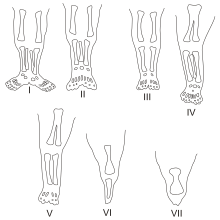Sirenomelia
| Sirenomelia | |
|---|---|
 | |
| Sirenomelia, Lyon natural history and anatomy museum | |
| Classification and external resources | |
| Specialty | medical genetics |
| ICD-10 | Q87.2 |
| ICD-9-CM | 759.89 |
| MeSH | D004480 |

Sirenomelia, alternatively known as Mermaid Syndrome, is a rare congenital deformity in which the legs are fused together, giving them the appearance of a mermaid's tail.
This condition is found in approximately one out of every 100,000 live births[1] (about as rare as conjoined twins) and is usually fatal within a day or two of birth because of complications associated with abnormal kidney and urinary bladder development and function. More than half the cases of sirenomelia result in stillbirth and this condition is 100 times more likely to occur in identical twins than in single births or fraternal twins.[2] It results from a failure of normal vascular supply from the lower aorta in utero. Maternal diabetes has been associated with caudal regression syndrome and sirenomelia,[3] although a few sources question this association.[4]
VACTERL-H is an expanded form of the VACTERL association that concludes that this diagnosis is a less severe form of sirenomelia.[5] The disorder was formerly thought to be an extreme case of caudal regression syndrome; however, it was reclassified to be considered a separate condition.
Notable cases

I) all bones of thigh and lower leg present
II) fused fibula
III) fibula absent
IV) partially fused femur, fused fibula
V) partially fused femur
VI) fused femur, fused tibia
VII) fused femur, tibia absent
Only a few individuals who did not have fatal kidney and bladder complications are known to have survived beyond birth with this condition.
Tiffany Yorks
Tiffany Yorks of Clearwater, Florida (May 7, 1988 - February 24, 2016)[6] underwent successful surgery in order to separate her legs before she was a year old.[7] She was the longest-surviving sirenomelia patient to date.[8] She suffered mobility issues due to her fragile leg bones, and compensated by using crutches or a wheelchair. She died on February 24, 2016 at the age of 27.
Shiloh Pepin
Shiloh Jade Pepin (August 4, 1999 – October 23, 2009) was born in Kennebunkport, Maine, United States with her lower extremities fused, no bladder, no uterus, no rectum, only 6 inches of large colon, no vagina, and with only one quarter of a kidney and one ovary. Her parents initially anticipated she could expect only a few months of life. Her natural kidney failed when she was just 3 months old. After that she was on dialysis.[9] A kidney transplant at age 2 lasted a number of years, and in 2007 a second kidney transplant was successful. She attended Consolidated Elementary School. She remained hopeful about her disease and joked often and lived her life happily, despite her challenges, as seen in her documentary in "Extraordinary People: Mermaid Girl". Still, there were times when she felt she couldn't bear to be ill any longer. Shiloh and her family were debating surgery because of the risks involved, even though it would improve her quality of life. Many people who have this condition receive surgery when they are young, but Shiloh was already 8 years old in the documentary and had not received surgery. Shiloh was the only one of the three survivors of sirenomelia without surgery for separation of the conjoined legs.[2] She died fighting a serious case of pneumonia on October 23, 2009, at Maine Medical Center in Portland, Maine, at the age of 10;[10] having appeared on the Oprah Winfrey Show on September 22, 2009.[11] Shiloh gained a following of admirers by documenting her condition on TV, Facebook, and the Internet. Shiloh was also the main character of the TLC special "Mermaid Girl," that was dedicated to her memory.
Seven days later, Shiloh was laid to rest in West Kennebunkport, Maine at Pine Grove Cemetery, next to her stillborn sister Molly Pepin on October 30, 2009. Her mother Leslie died unexpectedly on October 1, 2014.
Milagros Cerrón
Milagros Cerrón Arauco was born on April 27, 2004, in Huancayo, Peru. Although most of Milagros’ internal organs, including her heart and lungs, are in perfect condition, she was born with serious internal defects, including a deformed left kidney and a very small right one located very low in her body. In addition, her digestive, urinary tracts and genitals share a single tube. This birth defect occurs during the gastrulation week (week 3) of embryonic development. Gastrulation establishes the three germ layers: ectoderm, mesoderm and endoderm. It seems that complications such as defects in the urogenital system as mentioned above can be possibly due to malformations in the intermediate mesoderm.
A four-hour operation to insert silicone bags between her legs to stretch the skin was successfully completed on February 8, 2005. A successful operation to separate her legs to just above the knee took place May 31, 2005, in a "Solidarity Hospital" in the district of Surquillo in Lima. The procedure, however, was so intensive that she became traumatized to the degree of losing her ability to form proper speech patterns, leaving her nearly mute. It is not yet known if this is a physiological or psychological condition. However, at Milagros' second birthday, her mother reported that she knew more than 50 words. A second operation to complete the separation up to the groin took place on September 7, 2006.[12] A few weeks later, she took her first steps.[13]
Her doctor Luis Rubio said he was pleased with the progress Milagros had made, but cautioned that she still needed 10 to 15 years of rehabilitation and more operations before she could lead a normal life. Particularly, she will require reconstructive surgery to rebuild her rudimentary anus, urethra and genitalia.
Milagros' parents are from a poor village in Peru's Andes Mountains; the Solidarity Hospital has given a job to her father Ricardo Cerrón so that the family can remain in Lima, while the City of Lima has pledged to pay for many of the operations.[14]
References
- ↑ Kallen, B; Castilla, E E; Lancaster, P A; Mutchinick, O; Knudsen, L B; Martinez-Frias, M L; Mastroiacovo, P; Robert, E (1992). "The cyclops and the mermaid: An epidemiological study of two types of rare malformation". Journal of Medical Genetics. 29 (1): 30–5. doi:10.1136/jmg.29.1.30. PMC 1015818
 . PMID 1552541.
. PMID 1552541. - 1 2 Sammons, Mary Beth (November 26, 2009). "10-Year-Old Girl Born With Legs Fused Together". AOL. Archived from the original on November 26, 2009.
- ↑ Abraham M. Rudolph; Robert K. Kamei; Kim J. Overby (2002). Rudolph's Fundamentals of Pediatrics. McGraw Hill. p. 217. ISBN 978-0-8385-8450-7. Retrieved 2008-04-21.
- ↑ Assimakopoulos, E; Athanasiadis, A; Zafrakas, M; Dragoumis, K; Bontis, J (2004). "Caudal regression syndrome and sirenomelia in only one twin in two diabetic pregnancies". Clinical and experimental obstetrics & gynecology. 31 (2): 151–3. PMID 15266776.
- ↑ Onyeije, Chukwuma; Sherer, David; Handwerker, Sara; Shah, Leena (2008). "Prenatal Diagnosis of Sirenomelia with Bilateral Hydrocephalus: Report of a Previously Undocumented form of VACTERL-H Association". American Journal of Perinatology. 15 (3): 193–7. doi:10.1055/s-2007-993925. PMID 9572377.
- ↑ https://twitter.com/TiffanyYorks/status/702573145534783489
- ↑ "'Mermaid' girl takes first steps". BBC News. September 26, 2006. Retrieved May 23, 2010.
- ↑ "'Mermaid girl' to have legs split". BBC News. February 4, 2005. Retrieved May 23, 2010.
- ↑ TV program Body Shock, 10–11 pm, 18 May 2010, Channel 4
- ↑ Laura Dolce (2009-10-23). "Community saddened at 'Mermaid girl' Shiloh Pepin's passing". SeacoastOnline.com. Retrieved 2011-12-01.
- ↑ "SHILOH PEPIN". The Oprah Show. oprah.com. May 16, 2011. Retrieved 4 March 2014.
In Memoriam: The Oprah Show has hosted a number of unforgettable guests over the years. Look back at some of those who are no longer with us.
- ↑ BBC News 24, September 7, 2006,"Mermaid" girl's legs separated
- ↑ Daily Mail September 27, 2006, "Mermaid" girl takes her first unaided steps
- ↑ BBC News September 28, 2006, "Mermaid" girl takes first steps
Further reading
- Taori KB, Mitra K, Ghonga NP, Gandhi RO, Mammen T, Sahu J (2002). "Sirenomelia sequence (mermaid): Report of three cases". Indian J Radiol Imaging. 12 (3): 399–401.